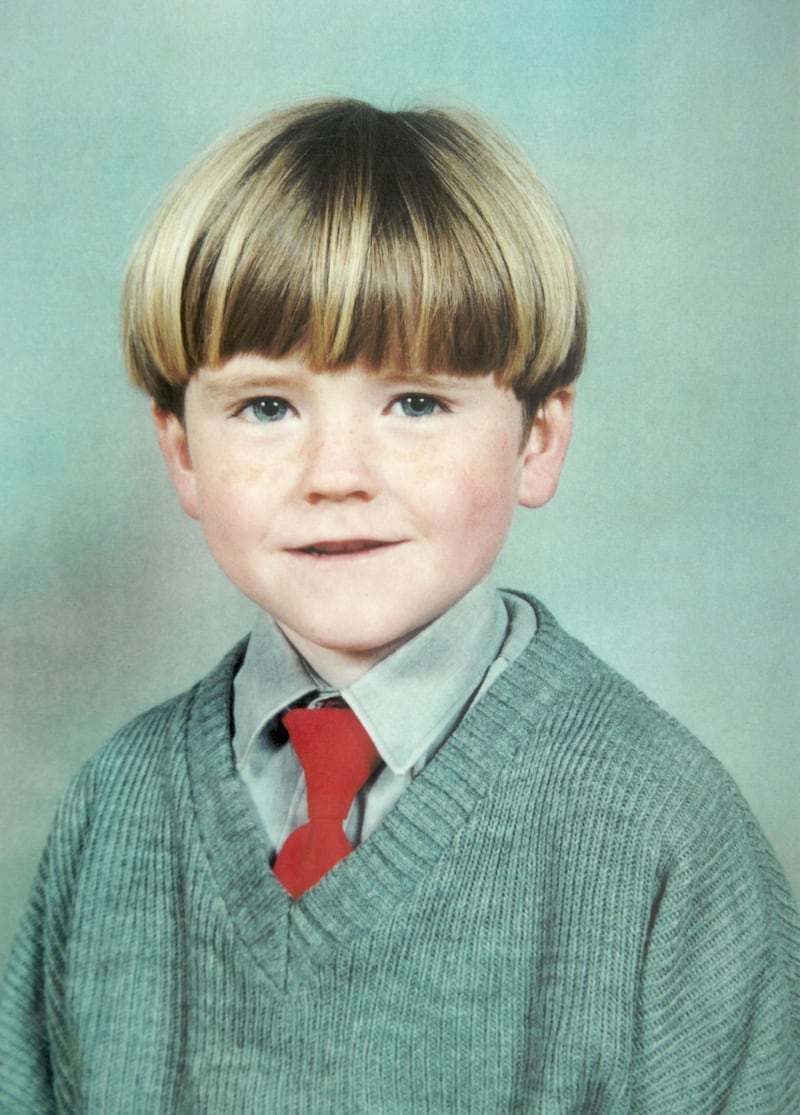When Oran Doherty got off the bus in Omagh on the way back to Buncrana, he bought himself a whole cooked chicken. It’s exactly what a hungry eight year-old kid released from home for a day, with money in his pocket, would do. As Ronan McGrory, a bigger boy who was looking out for Oran, told the public inquiry into the massacre of August 15th 1998, “I mean, he started eating it when we were standing on the street, so he did.”
It must have been a funny sight, a little kid with a big chicken, tearing it apart with his fingers and relishing the primitive joy of stuffing his face with more meat than he ever imagined having all to himself. It was while he was steeped in this pure pleasure that the explosion hit him.
Oran’s body was listed in the morgue as number 15. At the subsequent inquest, counsel for the coroner asked a policemen to describe how he found Oran. He replied that “he came across a wee boy of about eight to ten years old and that his hair was still on fire but that he was dead”. When Oran’s mother got to see him, it was his hair that struck her: “Oh, it was just something that I’ll never forgot, seeing him laying there, he was so badly marked, but his hair was wet for some reason and it had changed colour, it was dark.”
But what haunts her even more is the dread that Oran might not have died instantly. Most witnesses said he had, and there was some comfort in that. But “later, we were told that a nurse who was on the street that day, that she was talking to him and that Oran spoke to her” and asked for his mother. “After believing he must have died quick, I started to think the worst, that he knew what was going on around him ... the thought that he did ask for me and I was fifty miles away, is too much.”
READ MORE

Even reading the testimony given by survivors and bereaved families at the Omagh inquiry over the last few weeks is too much. Its website carries the warning: “This page may contain matters that may cause considerable distress.” There is no “may” about it. The distress, like the devil, is in the details. And yet we owe it to those witnesses to let these details pass through the filters we use to keep the unbearable at bay. For it is only those particularities that transform body number 15 back into the funny kid eating the chicken, a boy called Oran that everybody loved.
On the Saturday before the atrocity, Kevin Skelton refereed the Tyrone senior ladies county final between St Macartan’s and Dungannon and Jolene Marlow starred at half back for St Macartan’s. On the day of the bombing, Kevin was in Omagh with his wife Mena and their daughters. Jolene went to meet her little sister Nicola who was out in the town on her own for the first time , to buy concert tickets with money she had earned babysitting. Kevin had to find Mena’s dead body “face down in the rubble”. Jolene was killed and Nicola was maimed.
Kevin, even while grieving for Mena, went to visit the Marlows: “I went up to the house to Joe’s, you know, and to walk in – her remains weren’t home and her [football] jersey was lying on the bed, spread out, and the match programme was down in the corner but it was opened on my photograph ... I always remember that. That will never leave.”
Other things should never leave: Pauline Harte, perhaps because she was an art student, being puzzled by the colours of the fire in the car engine that had been blown on top of her – “I didn’t know it was a fire, because the fire has the colour yellow in it. I saw deep black, orange and red colours moving and it sounded as angry as it looked.” The rescuer who later told her “that he went home with my skin melted into his hands”.
The “wee jar of honeycomb” that Oran “had eaten one bit but then wrapped it up again” that was left on the tour bus and that his mother still keeps. The bouquet of blue flowers that Caroline Martin left on the communion table during her wedding to mark the presence of her “silent special bridesmaid”, her sister Esther Gibson who was killed in the bombing. The watch that was the only thing by which John McLaughlin could identify the body of his 12-year-old son Sean.
The insistence of Sean’s mother Patricia that his coffin be left open: “The state of his face meant that it took a lot longer than they thought it would” to make the sight bearable. Veda Short having her photograph taken with her newborn grandson the night before she was killed.
[ Omagh bombing inquiry: ‘World stood still’ in aftermath of explosionOpens in new window ]
The blood in Lorraine Wilson’s eye: “There was a little pool of blood in Lorraine’s eye and I remember Dad asking for a tissue to collect the little pool of blood, and he said, ‘This is all I have of you now’.” Valerie Hamilton finding it hard to move the hands she had thrown up around her head when the bomb went off, so that when she was trying to get her little daughter ready for school, “I couldn’t button her shirt with my hand at the time and this made me so angry”.
Such specifics make each victim unique. Yet Omagh itself was not – the horror was not so different on Bloody Friday or in Dublin, Monaghan, Enniskillen, Birmingham, Claudy, La Mon, Guilford. But it is all now processed into songs and chants, served up as recreational patriotism, safely distanced in the indifference of “that was a long time ago” or the insouciance of “there was no alternative”. We should not need to be hit by this shrapnel of exploded lives to know that it wasn’t and there was.















